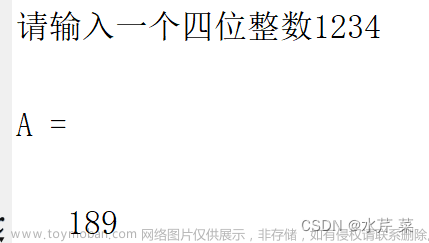这次的练习主要是一些类的高阶操作,像继承、接口和内部类这些,但其实还是挺简单的
目录
7-1 jmu-Java-03面向对象基础-04-形状-继承
前言
本题描述
思考
输入样例:
输出样例:
7-3 jmu-Java-04面向对象进阶-03-接口-自定义接口ArrayIntegerStack
main方法说明
思考
输入样例
输出样例
7-3 教师类
输入格式:
输出格式:
输入样例:
输出样例:
7-4 教师类-2
输入格式:
输出格式:
输入样例:
输出样例:
7-5 编写一个类Shop(商店)、内部类InnerCoupons(内部购物券)
输入格式:
输出格式:
输入样例:
输出样例:
7-6 jmu-Java-04面向对象进阶-01-接口-Comparable
1.编写PersonSortable类
2.main方法中
输入样例:
输出样例:
7-7 jmu-Java-03面向对象-06-继承覆盖综合练习-Person、Student、Employee、Company
main方法说明
输入样例:
输出样例:
7-8 定义接口(Biology、Animal)、类(Person)、子类(Pupil)
输入格式:
输出格式:
输入样例:
输出样例:
7-9 Employee类的层级结构
输入格式:
输出格式:
输入样例:
输出样例:
7-1 jmu-Java-03面向对象基础-04-形状-继承
前言
前面题目形状中我们看到,为了输出所有形状的周长与面积,需要建立多个数组进行多次循环。这次试验使用继承与多态来改进我们的设计。
本题描述
1.定义抽象类Shape
属性:不可变静态常量double PI,值为3.14,
抽象方法:public double getPerimeter(),public double getArea()
2.Rectangle与Circle类均继承自Shape类。
Rectangle类(属性:int width,length)、Circle类(属性:int radius)。
带参构造方法为Rectangle(int width,int length),Circle(int radius)。toString方法(Eclipse自动生成)
3.编写double sumAllArea方法计算并返回传入的形状数组中所有对象的面积和与double sumAllPerimeter方法计算并返回传入的形状数组中所有对象的周长和。
4.main方法
4.1 输入整型值n,然后建立n个不同的形状。如果输入rect,则依次输入宽、长。如果输入cir,则输入半径。
4.2 然后输出所有的形状的周长之和,面积之和。并将所有的形状信息以样例的格式输出。 提示:使用Arrays.toString。
4.3 最后输出每个形状的类型与父类型.使用类似shape.getClass() //获得类型, shape.getClass().getSuperclass() //获得父类型;
注意:处理输入的时候使用混合使用nextInt与nextLine需注意行尾回车换行问题。
思考
- 你觉得sumAllArea和sumAllPerimeter方法放在哪个类中更合适?
- 是否应该声明为static?
输入样例:
4
rect
3 1
rect
1 5
cir
1
cir
2
输出样例:
38.84
23.700000000000003
[Rectangle [width=3, length=1], Rectangle [width=1, length=5], Circle [radius=1], Circle [radius=2]]
class Rectangle,class Shape
class Rectangle,class Shape
class Circle,class Shape
class Circle,class Shape
import java.math.*;
import java.util.*;
abstract class Shape{
final double PI = 3.14;
public abstract double getPerimeter();
public abstract double getArea();
}
class Rectangle extends Shape{
private int length = 0;
private int width = 0;
public Rectangle(int _length,int _width){
this.length = _length;
this.width = _width;
}
public double getArea(){
return this.width * this.length;
}
public double getPerimeter(){
return (this.width + this.length)*2;
}
public String toString(){
return "Rectangle [width=" + this.length + ", length=" + this.width + "]";
}
}
class Circle extends Shape{
private int radius = 0;
public Circle(int _radius){
this.radius = _radius;
}
public double getPerimeter(){
return this.radius * PI * 2;
}
public double getArea(){
return this.radius * PI * this.radius;
}
public String toString(){
return "Circle [radius=" + this.radius + "]";
}
}
public class Main {
static Scanner in = new Scanner(System.in);
public static void main(String[] args) {
int n = in.nextInt();
ArrayList<Shape> shape = new ArrayList<Shape>();
double sumArea = 0;
double sumPerimeter = 0;
for(int i=0;i<n;i++){
String op = in.next();
if(op.equals("rect")){
int width = in.nextInt();
int length = in.nextInt();
shape.add(new Rectangle(width,length));
}
if(op.equals("cir")){
int radius = in.nextInt();
shape.add(new Circle(radius));
}
}
for(int i=0;i<n;i++){
sumArea += shape.get(i).getArea();
sumPerimeter += shape.get(i).getPerimeter();
}
System.out.println(sumPerimeter);
System.out.println(sumArea);
System.out.println(shape.toString());
for(int i=0;i<n;i++){
System.out.println(shape.get(i).getClass() + "," + shape.get(i).getClass().getSuperclass());
}
}
}
7-3 jmu-Java-04面向对象进阶-03-接口-自定义接口ArrayIntegerStack
定义IntegerStack接口,用于声明一个存放Integer元素的栈的常见方法:
public Integer push(Integer item); //如果item为null,则不入栈直接返回null。如果栈满,也返回null。如果插入成功,返回item。 public Integer pop(); //出栈,如果为空,则返回null。出栈时只移动栈顶指针,相应位置不置为null public Integer peek(); //获得栈顶元素,如果为空,则返回null. public boolean empty(); //如果为空返回true public int size(); //返回栈中元素个数
定义IntegerStack的实现类ArrayIntegerStack,内部使用数组实现。创建时,可指定内部数组大小。
main方法说明
- 输入n,建立可包含n个元素的ArrayIntegerStack对象
- 输入m个值,均入栈。每次入栈均打印入栈返回结果。
- 输出栈顶元素,输出是否为空,输出size
- 使用Arrays.toString()输出内部数组中的值。
- 输入x,然后出栈x次,每次出栈均打印。
- 输出栈顶元素,输出是否为空,输出size
- 使用Arrays.toString()输出内部数组中的值。
思考
如果IntegerStack接口的实现类内部使用ArrayList来存储元素,怎么实现?测试代码需要进行什么修改?
输入样例
5
3
1 2 3
2
输出样例
1
2
3
3,false,3
[1, 2, 3, null, null]
3
2
1,false,1
[1, 2, 3, null, null]
import java.math.*;
import java.util.*;
interface IntegerStack{
public Integer push(Integer item);
public Integer pop();
public Integer peek();
public boolean empty();
public int size();
}
class ArrayIntegerStack implements IntegerStack{
Integer[] array;
int len = 0;
int length = 0;
public ArrayIntegerStack(int _len){
this.array = new Integer[_len];
this.length = _len;
}
public Integer push(Integer item){
if(this.array == null){
return null;
}
if(this.len == this.length){
return null;
}
array[this.len] = item;
this.len++;
return item;
}
public Integer pop(){
if(this.len == 0){
return null;
}
this.len--;
return this.array[this.len];
}
public Integer peek(){
if(this.len == 0){
return null;
}
return this.array[this.len-1];
}
public boolean empty(){
if(this.len == 0){
return true;
}
return false;
}
public int size(){
return this.len;
}
public String toString(){
String res = "[";
for(int i=0;i<length - 1;i++){
res += this.array[i];
res += ", ";
}
res += this.array[this.length - 1];
res += "]";
return res;
}
}
public class Main {
static Scanner in = new Scanner(System.in);
public static void main(String[] args) {
int n = in.nextInt();
ArrayIntegerStack ais = new ArrayIntegerStack(n);
int m = in.nextInt();
for(int i=0;i<m;i++){
int tmp = in.nextInt();
System.out.println(ais.push(tmp));
}
System.out.println(ais.peek() + "," + ais.empty() + "," + ais.size());
System.out.println(ais.toString());
int x = in.nextInt();
for(int i=0;i<x;i++){
System.out.println(ais.pop());
}
System.out.println(ais.peek() + "," + ais.empty() + "," + ais.size());
System.out.println(ais.toString());
}
}7-3 教师类
设计一个教师类Teacher,要求:
属性有编号(int no)、姓名(String name)、年龄(int age)、所属学院(String seminary),为这些属性设置相应的get和set方法。
为Teacher类重写equals方法,要求:当两个教师对象的no相同时返回true。
重写Teacher类的toString方法,通过该方法可以返回“no: , name:, age: **, seminary: **”形式的字符串。
输入格式:
两个教师对象的编号,姓名,年龄,学院
输出格式:
教师的信息
两个教师是否相等
输入样例:
在这里给出一组输入。例如:
1 Linda 38 SoftwareEngineering
2 Mindy 27 ComputerScience
输出样例:
在这里给出相应的输出。例如:
no: 1, name:Linda, age: 38, seminary: SoftwareEngineering
no: 2, name:Mindy, age: 27, seminary: ComputerScience
false
import java.math.*;
import java.util.*;
class Teacher{
private int no;
private String name;
private int age;
private String seminary;
public Teacher(int _no,String _name,int _age,String _seminary){
this.age = _age;
this.name = _name;
this.no = _no;
this.seminary = _seminary;
}
public boolean equals(Teacher a){
return this.age == a.age && this.no == a.no && this.seminary.equals(a.seminary) && this.name.equals(a.name);
}
public String toString(){
return "no: " + this.no + ", name:" + this.name + ", age: " + this.age + ", seminary: " + this.seminary;
}
}
public class Main {
static Scanner in = new Scanner(System.in);
public static void main(String[] args) {
int no = in.nextInt();
String name = in.next();
int age = in.nextInt();
String seminary = in.next();
Teacher t1 = new Teacher(no,name,age,seminary);
no = in.nextInt();
name = in.next();
age = in.nextInt();
seminary = in.next();
Teacher t2 = new Teacher(no,name,age,seminary);
System.out.println(t1.toString());
System.out.println(t2);
System.out.println(t1.equals(t2));
}
}
7-4 教师类-2
修改题目143
- 修改教师类,使得由多个Teacher对象所形成的数组可以排序(编号由低到高排序),并在main函数中使用Arrays.sort(Object[] a)方法排序
- 定义一个类TeacherManagement,包含教师数组,提供方法add(Teacher[]),使其可以添加教师,提供重载方法search,方法可以在一组给定的教师中,根据姓名或年龄返回等于指定姓名或年龄的教师的字符串信息,信息格式为:“no: , name:, age: **, seminary: **”。如果没有满足条件的教师,则返回“no such teacher”。
输入格式:
教师个数
教师信息
待查找教师的姓名
待查找教师的年龄
输出格式:
排序后的信息
按姓名查找的老师信息
按年龄查找的老师信息
输入样例:
在这里给出一组输入。例如:
4
3 Linda 38 SoftwareEngineering
1 Mindy 27 ComputerScience
4 Cindy 28 SoftwareEngineering
2 Melody 27 ComputerScience
Cindy
27
输出样例:
在这里给出相应的输出。例如:
no: 1, name: Mindy, age: 27, seminary: ComputerScience
no: 2, name: Melody, age: 27, seminary: ComputerScience
no: 3, name: Linda, age: 38, seminary: SoftwareEngineering
no: 4, name: Cindy, age: 28, seminary: SoftwareEngineering
search by name:
no: 4, name: Cindy, age: 28, seminary: SoftwareEngineering
search by age:
no: 1, name: Mindy, age: 27, seminary: ComputerScience
no: 2, name: Melody, age: 27, seminary: ComputerScienceimport java.math.*;
import java.util.*;
class Teacher{
private int no;
private String name;
private int age;
private String seminary;
public Teacher(int _no,String _name,int _age,String _seminary){
this.age = _age;
this.name = _name;
this.no = _no;
this.seminary = _seminary;
}
public int getAge(){
return this.age;
}
public String getName(){
return this.name;
}
public int getNo(){
return this.no;
}
public boolean equals(Teacher a){
return this.age == a.age && this.no == a.no && this.seminary.equals(a.seminary) && this.name.equals(a.name);
}
public String toString(){
return "no: " + this.no + ", name: " + this.name + ", age: " + this.age + ", seminary: " + this.seminary;
}
}
class TeacherManagement{
public ArrayList<Teacher> teachers = new ArrayList<Teacher>();
public void add(Teacher t){
this.teachers.add(t);
}
public void search(int _age){
int flag = 1;
System.out.println("search by age:");
for(int i=0;i<teachers.size();i++){
if(_age == teachers.get(i).getAge()){
flag = 0;
System.out.println(teachers.get(i));
}
}
if(flag == 1){
System.out.println("no such teacher");
}
}
public void search(String _name){
int flag = 1;
System.out.println("search by name:");
for(int i=0;i<teachers.size();i++){
if(_name.equals(teachers.get(i).getName())){
flag = 0;
System.out.println(teachers.get(i));
}
}
if(flag == 1){
System.out.println("no such teacher");
}
}
public void sort(){
for(int i=0;i<teachers.size();i++){
for(int j=0;j<teachers.size()-1;j++){
if(teachers.get(i).getNo() < teachers.get(j).getNo()){
Teacher tmp = teachers.get(i);
teachers.set(i,teachers.get(j));
teachers.set(j,tmp);
}
}
}
}
}
public class Main {
static Scanner in = new Scanner(System.in);
public static void main(String[] args) {
int num = in.nextInt();
TeacherManagement tm = new TeacherManagement();
for(int i=0;i<num;i++){
int no = in.nextInt();
String name = in.next();
int age = in.nextInt();
String seminary = in.next();
Teacher tmp = new Teacher(no,name,age,seminary);
tm.add(tmp);
}
tm.sort();
for(int i=0;i<tm.teachers.size();i++){
System.out.println(tm.teachers.get(i));
}
String s = in.next();
int nm = 0;
try{
nm = Integer.valueOf(s);
tm.search(nm);
} catch (Exception e){
tm.search(s);
}
s = in.next();
try{
nm = Integer.valueOf(s);
tm.search(nm);
} catch (Exception e){
tm.search(s);
}
}
}
7-5 编写一个类Shop(商店)、内部类InnerCoupons(内部购物券)
编写一个类Shop(商店),该类中有一个成员内部类InnerCoupons(内部购物券),可以用于购买该商店的牛奶(假设每箱牛奶售价为50元)。要求如下:
(1)Shop类中有私有属性milkCount(牛奶的箱数,int类型)、公有的成员方法setMilkCount( )和getMilkCount( )分别用于设置和获取牛奶的箱数。
(2)成员内部类InnerCoupons,有公有属性value(面值,int类型),一个带参数的构造方法可以设定购物券的面值value,一个公有的成员方法buy( )要求输出使用了面值为多少的购物券进行支付,同时使商店牛奶的箱数减少value/50。
(3)Shop类中还有成员变量coupons50(面值为50元的内部购物券,类型为InnerCoupons)、coupons100(面值为100元的内部购物券,类型为InnerCoupons)。
(4)在Shop类的构造方法中,调用内部类InnerCoupons的带参数的构造方法分别创建上面的购物券coupons50、coupons100。
在测试类Main中,创建一个Shop类的对象myshop,从键盘输入一个整数(大于或等于3),将其设置为牛奶的箱数。假定有顾客分别使用了该商店面值为50的购物券、面值为100的购物券各消费一次,分别输出消费后商店剩下的牛奶箱数。
输入格式:
输入一个大于或等于3的整数。
输出格式:
使用了面值为50的购物券进行支付
牛奶还剩XX箱
使用了面值为100的购物券进行支付
牛奶还剩XX箱
输入样例:
在这里给出一组输入。例如:
5
输出样例:
在这里给出相应的输出。例如:
使用了面值为50的购物券进行支付
牛奶还剩4箱
使用了面值为100的购物券进行支付
牛奶还剩2箱import java.math.*;
import java.util.*;
class Shop{
private int milkCount;
public InnerCoupons coupons50 = new InnerCoupons(50);
public InnerCoupons coupons100 = new InnerCoupons(100);
public void setMilkCount(int nums){
this.milkCount = nums;
}
public int getMilkCount(){
return this.milkCount;
}
public Shop(int nums){
this.milkCount = nums;
}
public class InnerCoupons{
public int value;
public InnerCoupons(int _value){
this.value = _value;
}
public void buy(){
System.out.println("使用了面值为" + value + "的购物券进行支付");
milkCount -= value/50;
System.out.println("牛奶还剩" + milkCount + "箱");
}
}
}
public class Main {
static Scanner in = new Scanner(System.in);
public static void main(String[] args) {
int n = in.nextInt();
Shop shop = new Shop(n);
shop.coupons50.buy();
shop.coupons100.buy();
}
}
7-6 jmu-Java-04面向对象进阶-01-接口-Comparable
编写实现Comparable接口的PersonSortable类,使其按name以及age排序
1.编写PersonSortable类
属性:private name(String)、private age(int)
有参构造函数:参数为name,age
toString函数:返回格式为:name-age
实现Comparable接口:实现先对name升序排序,如果name相同则对age进行升序排序
2.main方法中
- 首先输入n
- 输入n行name age,并创建n个对象放入数组
- 对数组进行排序后输出。
- 最后一行使用
System.out.println(Arrays.toString(PersonSortable.class.getInterfaces()));输出PersonSortable所实现的所有接口
输入样例:
5
zhang 15
zhang 12
wang 14
Wang 17
li 17
输出样例:
Wang-17
li-17
wang-14
zhang-12
zhang-15
//这行是标识信息import java.math.*;
import java.util.*;
class PersonSortable implements Comparable<PersonSortable>{
private String name;
private int age;
public String getName(){
return this.name;
}
public int getAge(){
return this.age;
}
public PersonSortable(String _name,int _age){
this.name = _name;
this.age = _age;
}
public String toString(){
return this.name + "-" + this.age;
}
public int compareTo(PersonSortable person){
if(this.name.equals(person.getName())){
return this.age - person.getAge();
}
return this.name.compareTo(person.getName());
}
}
public class Main {
static Scanner in = new Scanner(System.in);
public static void main(String[] args) {
int n = in.nextInt();
PersonSortable[] ps = new PersonSortable[n];
for(int i=0;i<n;i++){
String name = in.next();
int age = in.nextInt();
ps[i] = new PersonSortable(name,age);
}
Arrays.sort(ps);
for(PersonSortable p : ps){
System.out.println(p);
}
System.out.println(Arrays.toString(PersonSortable.class.getInterfaces()));
}
}
7-7 jmu-Java-03面向对象-06-继承覆盖综合练习-Person、Student、Employee、Company
定义Person抽象类,Student类、Company类,Employee类。
Person类的属性:String name, int age, boolean gender
Person类的方法:
public Person(String name, int age, boolean gender);
public String toString(); //返回"name-age-gender"格式的字符串
public boolean equals(Object obj);//比较name、age、gender,都相同返回true,否则返回false
Student类继承自Person,属性:String stuNo, String clazz
Student类的方法:
//建议使用super复用Person类的相关有参构造函数
public Student(String name, int age, boolean gender, String stuNo, String clazz);
public String toString(); //返回 “Student:person的toString-stuNo-clazz”格式的字符串
public boolean equals(Object obj);//首先调用父类的equals方法,如果返回true,则继续比较stuNo与clazz。
Company类属性:String name
Company类方法:
public Company(String name);
public String toString(); //直接返回name
public boolean equals(Object obj);//name相同返回true
Employee类继承自Person,属性:Company company, double salary
Employee类方法:
//建议使用super复用Person类的相关有参构造函数
public Employee(String name, int age, boolean gender, double salary, Company company);
public String toString(); //返回"Employee:person的toString-company-salary"格式的字符串
public boolean equals(Object obj);//首先调用父类的equals方法,如果返回true。再比较company与salary。
//比较salary属性时,使用DecimalFormat df = new DecimalFormat("#.#");保留1位小数
编写equals方法重要说明:
- 对Employee的company属性的比较。要考虑传入为
null的情况。如果company不为null且传入为null,返回false - 对所有String字符类型比较时,也要考虑
null情况。
提示
- 排序可使用Collections.sort
- equals方法要考虑周全
main方法说明
- 创建若干Student对象、Employee对象。
输入s,然后依次输入name age gender stuNo clazz创建Student对象。
输入e,然后依次输入name age gender salary company创建Employee对象。
然后将创建好的对象放入List<Person> personList。输入其他字符,则结束创建。
创建说明: 对于String类型,如果为null则不创建对象,而赋值为null。对于company属性,如果为null则赋值为null,否则创建相应的Company对象。
-
对personList中的元素实现先按照姓名升序排序,姓名相同再按照年龄升序排序。提示:可使用
Comparable<Person>或Comparator<Person> -
接受输入,如果输入为
exit则return退出程序,否则继续下面步骤。 -
将personList中的元素按照类型分别放到stuList与empList。注意:不要将两个内容相同的对象放入列表(是否相同是根据equals返回结果进行判定)。
-
输出字符串
stuList,然后输出stuList中的每个对象。 -
输出字符串
empList,然后输出empList中的每个对象。
1-3为一个测试点4-6为一个测试点
输入样例:
s zhang 23 false 001 net15
e wang 18 true 3000.51 IBM
s zhang 23 false 001 net15
e bo 25 true 5000.51 IBM
e bo 25 true 5000.52 IBM
e bo 18 true 5000.54 IBM
e tan 25 true 5000.56 IBM
e tan 25 true 5000.51 IBM
s wang 17 false 002 null
s wang 17 false 002 null
e hua 16 false 1000 null
s wang 17 false 002 net16
e hua 16 false 1000 null
e hua 18 false 1234 MicroSoft
!
continue
输出样例:
Employee:bo-18-true-IBM-5000.54
Employee:bo-25-true-IBM-5000.51
Employee:bo-25-true-IBM-5000.52
Employee:hua-16-false-null-1000.0
Employee:hua-16-false-null-1000.0
Employee:hua-18-false-MicroSoft-1234.0
Employee:tan-25-true-IBM-5000.56
Employee:tan-25-true-IBM-5000.51
Student:wang-17-false-002-null
Student:wang-17-false-002-null
Student:wang-17-false-002-net16
Employee:wang-18-true-IBM-3000.51
Student:zhang-23-false-001-net15
Student:zhang-23-false-001-net15
stuList
Student:wang-17-false-002-null
Student:wang-17-false-002-net16
Student:zhang-23-false-001-net15
empList
Employee:bo-18-true-IBM-5000.54
Employee:bo-25-true-IBM-5000.51
Employee:hua-16-false-null-1000.0
Employee:hua-18-false-MicroSoft-1234.0
Employee:tan-25-true-IBM-5000.56
Employee:tan-25-true-IBM-5000.51
Employee:wang-18-true-IBM-3000.51
import java.math.*;
import java.util.*;
import java.text.*;
class Person implements Comparable<Person>{
public String name;
public int age;
public boolean gender;
public Person(String name, int age, boolean gender){
this.name = name;
this.gender = gender;
this.age = age;
}
public String toString(){
return this.name + "-" + this.age + "-" + this.gender;
}
public boolean equals(Object obj){
Person ob = (Person) obj;
return this.name.equals(ob.name) && this.age == ob.age && this.gender == ob.gender;
}
public int compareTo(Person p){
if(this.name.equals(p.name)){
return this.age - p.age;
}
return this.name.compareTo(p.name);
}
}
class Student extends Person{
String stuNo;
String clazz;
//建议使用super复用Person类的相关有参构造函数
public Student(String name, int age, boolean gender, String stuNo, String clazz){
super(name,age,gender);
this.stuNo = stuNo;
this.clazz = clazz;
}
public String toString(){
return "Student:" + super.toString() + "-" + this.stuNo + "-" + this.clazz;
} //返回 “Student:person的toString-stuNo-clazz”格式的字符串
public boolean equals(Object obj){
if(super.equals(obj)==true){
Student ob = (Student)obj;
if(this.clazz.equals(ob.clazz) && this.stuNo.equals(ob.stuNo)){
return true;
}
}
return false;
}//首先调用父类的equals方法,如果返回true,则继续比较stuNo与clazz。
}
class Company{
String name;
public Company(String name){
this.name = name;
}
public String toString(){
return this.name;
}
public boolean equals(Object obj){
Company ob = (Company) obj;
return this.name.equals(ob.name);
}//name相同返回true
}
class Employee extends Person{
public Company company;
public double salary;
//建议使用super复用Person类的相关有参构造函数
public Employee(String name, int age, boolean gender, double salary, Company company){
super(name,age,gender);
this.salary = salary;
this.company = company;
}
public String toString(){
return "Employee:" + super.toString() + "-" + this.company + "-" + this.salary;
}
public boolean equals(Object obj){
if(super.equals(obj)){
Employee ob = (Employee)obj;
String a = new DecimalFormat("#.#").format(this.salary);
String b = new DecimalFormat("#.#").format(ob.salary);
return this.company.equals(ob.company) && a.equals(b);
}
return false;
}//首先调用父类的equals方法,如果返回true。再比较company与salary。
//比较salary属性时,使用DecimalFormat df = new DecimalFormat("#.#");保留1位小数
}
public class Main {
static Scanner in = new Scanner(System.in);
public static void main(String[] args) {
List<Person> ps = new ArrayList<>();
List<Student> st = new ArrayList<>();
List<Employee> em = new ArrayList<>();
while(true){
String op = in.next();
if(op.equals("s")){
String name = in.next();
int age = in.nextInt();
boolean gender = in.nextBoolean();
String stuNo = in.next();
String clazz = in.next();
Student s = new Student(name,age,gender,stuNo,clazz);
ps.add(s);
st.add(s);
}
else if(op.equals("e")){
String name = in.next();
int age = in.nextInt();
boolean gender = in.nextBoolean();
double salary = in.nextDouble();
String company = in.next();
Employee e = new Employee(name,age,gender,salary,new Company(company));
ps.add(e);
em.add(e);
}
else{
Collections.sort(ps);
for(int i=0;i<ps.size();i++) {
System.out.println(ps.get(i));
}
String tempString = in.next();
if(tempString.compareTo("exit")==0||tempString.compareTo("return")==0) {
return;
}
List<Student> tst = new ArrayList<>();
List<Employee> tem = new ArrayList<>();
System.out.println("stuList");
for(int i=0;i<st.size();i++) {
boolean flag = true;
for(int j=0;j<tst.size();j++){
if(st.get(i).equals(tst.get(j))){
//System.out.println(1);
flag = false;
}
}
if(flag){
tst.add(st.get(i));
}
}
Collections.sort(tst);
for(int i=0;i<tst.size();i++){
System.out.println(tst.get(i));
}
System.out.println("empList");
//System.out.println(em.size());
for(int i=0;i<em.size();i++) {
boolean flag = true;
for(int j=0;j<tem.size();j++){
if(em.get(i).equals(tem.get(j))){
flag = false;
}
}
if(flag){
tem.add(em.get(i));
}
}
Collections.sort(tem);
//System.out.println(tem.size());
for(int i=0;i<tem.size();i++){
System.out.println(tem.get(i));
}
}
}
}
}
7-8 定义接口(Biology、Animal)、类(Person)、子类(Pupil)
(1)定义Biology(生物)、Animal(动物)2个接口,其中Biology声明了抽象方法breathe( ),Animal声明了抽象方法eat( )和sleep( )。
(2)定义一个类Person(人)实现上述2个接口,实现了所有的抽象方法,同时自己还有一个方法think( )。breathe()、eat()、sleep()、think()四个方法分别输出:我喜欢呼吸新鲜空气我会按时吃饭早睡早起身体好我喜欢思考
(3)定义Person类的子类Pupil(小学生),有私有的成员变量school(学校),公有的成员方法setSchool( )、getSchool( )分别用于设置、获取学校信息。
(4)在测试类Main中,用Pupil类创建一个对象zhangsan。尝试从键盘输入学校信息给zhangsan,获取到该信息后输出该学校信息,格式为“我的学校是XXX”;依次调用zhangsan的breathe()、eat()、sleep()、think()方法。
输入格式:
从键盘输入一个学校名称(字符串格式)
输出格式:
第一行输出:我的学校是XXX(XXX为输入的学校名称)
第二行是breathe()方法的输出
第三行是eat()方法的输出
第四行是sleep()方法的输出
第五行是think()方法的输出
输入样例:
在这里给出一组输入。例如:
新余市逸夫小学
输出样例:
在这里给出相应的输出。例如:
我的学校是新余市逸夫小学
我喜欢呼吸新鲜空气
我会按时吃饭
早睡早起身体好
我喜欢思考
import java.math.*;
import java.util.*;
interface Biology{
abstract void breathe();
}
interface Animal{
abstract void eat();
abstract void sleep();
}
class Person implements Animal,Biology{
public void think(){
System.out.println("我喜欢思考");
}
public void eat(){
System.out.println("我会按时吃饭");
}
public void sleep(){
System.out.println("早睡早起身体好");
}
public void breathe(){
System.out.println("我喜欢呼吸新鲜空气");
}
}
class Pupil extends Person{
String school;
public void setSchool(String _school){
this.school = _school;
}
public String getSchool(){
return this.school;
}
}
public class Main {
static Scanner in = new Scanner(System.in);
public static void main(String[] args) {
String sc = in.next();
System.out.println("我的学校是" + sc);
Pupil p = new Pupil();
p.breathe() ;
p.eat();
p.sleep();
p.think();
}
}7-9 Employee类的层级结构
定义四个类,分别为Employee类、SalariedEmployee类、HourlyEmployee类和CommissionEmployee类。其中Employee类是其他三个类的父类。Employee类包含姓名和身份证号。除此之外,SalariedEmployee类还应包含每月工资;HourlyEmployee类还应包含每小时工资数和工作时间数;CommissionEmployee还应包含提成比例和销售总额。其中HourlyEmployee的工资为:每小时工资数×工作时间数,CommissionEmployee的工资为:提成比例×销售总额。每个类都应有合适的构造方法、数据成员的设置和读取方法。编写一个测试程序,创建这些类的对象,并输出与对象相关的信息。注意子类有时需调用父类的构造方法和被覆盖的方法,成员变量定义为private,对有些方法实现重载。测试程序如下所示:
public static void main(String [] args){
Scanner in=new Scanner(System.in);
Employee [] e=new Employee[3];
e[0]=new SalariedEmployee(in.next(),in.next(),in.nextDouble());
e[1]=new HourlyEmployee(in.next(),in.next(),in.nextDouble(),in.nextDouble());
e[2]=new CommissionEmployee(in.next(),in.next(),in.nextDouble(),in.nextDouble());
for(int i=0;i<e.length;i++)
{
System.out.println(e[i].getSalary());
System.out.println(e[i]);
}
}
输入格式:
输入三行。第一行为一个SalariedEmployee对象的姓名,身份证号和每月工资。第二行为一个HourlyEmployee对象的姓名、身份证号、每小时工资数、工作时间。第三行为一个CommissionEmployee对象的姓名、身份证号、提成比例和销售总额。
输出格式:
输出三个对象的工资和对象的其他信息。每一个对象输出两行,第一行为工资,第二行为对象的信息。文章来源:https://www.toymoban.com/news/detail-743518.html
输入样例:
Mike 0001 5000
Jack 0002 20 300
Tom 0003 0.2 50000
输出样例:
5000.0
SalariedEmployee[name=Mike,id=0001][monthSalary=5000.0]
6000.0
HourlyEmployee[name=Jack,id=0002][hourSalary=20.0,workhour=300.0]
10000.0
CommissionEmployee[name=Tom,id=0003][commissionRatio=0.2,sale=50000.0]import java.math.*;
import java.util.*;
class Employee{
String name;
String id;
public Employee(String _name, String _id){
this.name = _name;
this.id = _id;
}
public String toString(){
return "[name=" + this.name + ",id=" + this.id + "]";
}
public double getSalary(){
return 0.0;
}
}
class SalariedEmployee extends Employee{
double monthSalary;
public double getSalary(){
return this.monthSalary;
}
public String toString(){
return "SalariedEmployee" + super.toString() + "[monthSalary=" + this.monthSalary + "]";
}
public SalariedEmployee(String _name, String _id, double _monthSalary){
super(_name,_id);
this.monthSalary = _monthSalary;
}
}
class HourlyEmployee extends Employee{
double hourSalary;
double workhour;
public HourlyEmployee(String _name, String _id, double _hourSalary, double _workhour){
super(_name,_id);
this.hourSalary = _hourSalary;
this.workhour = _workhour;
}
public double getSalary(){
return this.hourSalary * this.workhour;
}
public String toString(){
return "HourlyEmployee" + super.toString() + "[hourSalary=" + this.hourSalary + ",workhour=" + this.workhour + "]";
}
}
class CommissionEmployee extends Employee{
double commissionRatio;
double sale;
public CommissionEmployee(String _name,String _id, double _commissionRatio, double _sale){
super(_name,_id);
this.commissionRatio = _commissionRatio;
this.sale = _sale;
}
public double getSalary(){
return this.sale * this.commissionRatio;
}
public String toString(){
return "CommissionEmployee" + super.toString() + "[commissionRatio=" + this.commissionRatio + ",sale=" + this.sale + "]";
}
}
public class Main {
public static void main(String [] args){
Scanner in = new Scanner(System.in);
Employee [] e = new Employee[3];
e[0] = new SalariedEmployee(in.next(),in.next(),in.nextDouble());
e[1] = new HourlyEmployee(in.next(),in.next(),in.nextDouble(),in.nextDouble());
e[2] = new CommissionEmployee(in.next(),in.next(),in.nextDouble(),in.nextDouble());
for(int i=0;i<e.length;i++){
System.out.println(e[i].getSalary());
System.out.println(e[i]);
}
}
}文章来源地址https://www.toymoban.com/news/detail-743518.html
到了这里,关于Java程序设计2023-第三次上机练习的文章就介绍完了。如果您还想了解更多内容,请在右上角搜索TOY模板网以前的文章或继续浏览下面的相关文章,希望大家以后多多支持TOY模板网!











